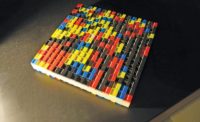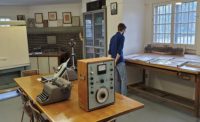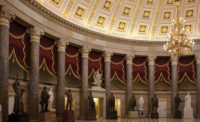Acoustic Assemblies
Why acoustic assemblies in your project underperform the lab tests.

It is to be expected that variations in the field will account for drop in performance from those measured in a laboratory, significantly worse performance can typically be traced to a failure to follow three simple checks.

Mitchell

Wolfram

Orfield

Moyer





It doesn’t seem fair that buildings that possess appropriate acoustics almost always go unnoticed, while projects that underperform acoustic specifications are constant topics of discussion. Adding insult to injury, many of these failures come as surprises to both the design and construction teams who thought they had acoustics covered with lab tested, acoustically rated walls, ceilings and building components. Although it is to be expected that variations in the field will account for a 5 dB drop in performance from those measured on the ideal assembly in a laboratory, significantly worse performance can typically be traced to a failure to follow three simple checks:
Check #1: Did an accredited lab perform the test?
There are over 70 acoustic rating systems, which are defined by ASTM, SAE, AAMA, ISO, NFPA, ECMA, IEC, MIL-STD, BS EN, AS/NZS and AS ISO standards with improved rating systems being continually developed as the science progresses. These same organizations publish stringent test procedures to be used to determine those ratings, each requiring specialized lab facilities and quality control procedures. A simple check of the accreditation status for the lab that produced your test report is assurance that the lab is qualified to perform those tests. In the United States, labs may be accredited for acoustics and other tests through the National Voluntary Laboratory Accreditation Program of the National Institute of Science and Technology. The NIST website gives a searchable listing of NVLAP accredited labs along with copies of their certifications. Since there are only 19 NVLAP accredited acoustic testing labs in the US and another four in Canada and Japan, verification of status is quick.
Accredited labs may be independent or they may be internal departments within acoustic manufacturers or acoustics services companies. One uniquely placed lab is that of Orfield Laboratories in Minneapolis. Steve Orfield built the lab to support his company’s consulting practice, comprising “Building Sciences,” a research-based design of buildings to meet a variety of human needs goals—not just acoustics.
Even though accredited labs use round robin tests to minimize variation, there remains some variation in test results between labs.
Andrew Mitchell, product manager for Pottorff [manufacturer of noise control silencers with in-house labs] remarks, “With respect to comparing products, the biggest issue I see in our industry is reproducibility of data [testing the same product in different laboratories]. The same test sample, tested in different facilities, has been found to yield significant differences. Therefore, even if you have multiple “certified” test reports, it still may be difficult to interpret the results.”
Check #2: Is the assembly in the field the same as the one tested in the lab?
Some very useful but often misused acoustical design tools are the wall, ceiling and floor assembly guides published by manufacturers and housing authorities. I typically see architects using these guides as UL/STC catalogs to select assemblies that have appropriate fire and acoustic ratings for their projects, while misinterpreting the required construction in their drawings. The importance of stud type, gauge, spacing and height on achieving the listed STC ratings of wall assemblies is routinely missed.
Eric Wolfram, the laboratory manager for Riverbank Acoustical Laboratories/Alion Science and Technology in Geneva, Illinois, has lectured on the potential hazards with current industry practices and offers recommendations for improvement.
“Manufacturers self-certify their products. Labs provide accredited tests on samples submitted by the manufacturer. Currently, no lab provides a complete certification process for acoustical materials that would involve validating the manufacturing process and regular verification of performance from production pieces. UL does this for fire certification and it is very expensive due to all of the paperwork and liability involved.” Eric encourages readers interested in viewing his complete presentation to email him at ewolfram@alionscience.com to request a copy.
Similar problems occur when marketing departments prepare product descriptions without engineering oversight.
“You must remember that anyone can offer a construction assembly with a test of a similar prior assembly and this is often the case in some product areas. So, we think due diligence of retesting on major projects is a good idea. Additionally, we have a rule of never specifying less than 5 to 10 points above minimums. I testify in court on failures and ‘trust but verify’ is the order of the day,” says Steve Orfield.
Check #3: Is the test report real?
Until recently, I advised that comparing data from signed test reports was sufficient; however, we’re now starting to encounter forged lab reports. To help combat this new threat, a few labs have started to digitally sign their test reports, which offer some protection although not fool proof without an independent certificate authority. Some labs are working on this, but cost is always a consideration. Blockchain encryption of the test report could be another method to maintain traceability of the report while providing a method to recover costs from the end users who benefit.
Although labs must demonstrate traceability of their test methods to maintain accreditation, there is no traceability standard for the test report itself. Kari Harper, program manager of Calibration LAP and Acoustical Testing Services LAP for the National Voluntary Laboratory Accreditation Program at NIST reminds us, “NVLAP’s role is to accredit laboratories, and we do not have a role in the issuance of individual test reports.” She suggests, “If NVLAP were notified about a potentially altered or falsified test report, we would contact our accredited laboratory so that they could investigate the issue.”
“It is very rare but I too have seen digitally altered test reports. This amounts to fraud and it is serious. These people are not making good risk management decisions,” says Eric Wolfram.
“Years ago, we started to see this happening and we are quite careful to compare ratings with known ratings in our data base. On major projects, we sometimes ask our client to insist on retesting with newly submitted samples. On one of these projects, four of the five submitted products failed to meet their submitted standards of 10-15 STC points,” says Steve Orfield.
Ironically, the forgery problem appears to be a bigger issue for the independent labs performing tests for outside clients than it is for labs internal to manufacturers.
“For Vibro-Acoustics specifically, we don’t produce a lot of reports from our lab for external use. Even if we did, it’s pretty unlikely anyone would care to forge a report from us, since they are pretty much all related to our products,” as Jonathan Peoples, Application/R&D engineering manager for VibroAcoustics points out.
In addition, fake test reports seem to be absent for products whose acoustics ratings are tied to occupational safety and health regulations.
Elliot H Berger, division scientist, 3M Personal Safety Division in Indianapolis confirms, “We have not run into that particular problem, and we … are not in the field of building acoustics in my labs, but rather that of testing hearing protector attenuation.”
Until labs issue reports having electronically verifiable signatures, the most common suggestion offered by the labs is to call them with any reports you aren’t sure of. Although the labs have confidentiality agreements with their clients, which generally prevents them from revealing test results, most said they could tell you if any report you already have is genuine or not.
Eric Wolfram recommends, “All of our testing is performed under strict confidentiality policy. I do not distribute reports or results to third parties without written permission. If someone sends me a test report, I can verify that it is unaltered. If there is any issue, I will tell them that there is some disagreement with the report but will not give specific details. I will also contact my customer to inform them of the issue.”
David Moyer, senior researcher at USG Corporation’s Corporate Innovation Center in Libertyville, Ill., says that when in doubt, “… Just call the lab with the test number and verify who it was done for, what it was done on and the value of the STC, NRC, etc. The caller would have to have the report with this minimum information to verify. No fishing for random reports allowed.”
While the labs work on improving variability and security, manufacturers, architects, engineers and contractors can help by using these three simple checks.
Eric Wolfram says, “I do believe that the current business model can work well if everyone is educated about the process. I would love to see more manufacturers publish complete information including formal test reports. They will not do that unless there is significant demand from their owners and consultants.”
Looking for a reprint of this article?
From high-res PDFs to custom plaques, order your copy today!














